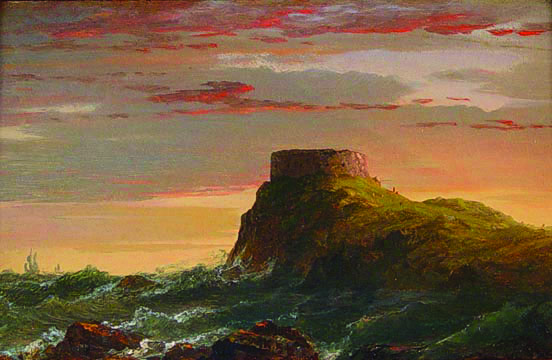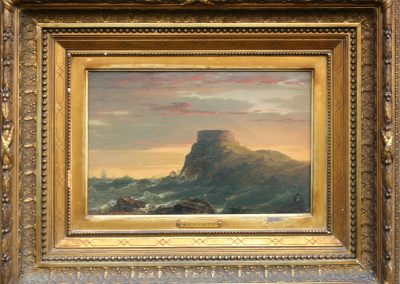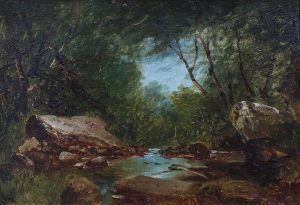John Frederick Kensett (1816-1872)
John Frederick Kensett, a leading member of the second generation of Hudson River School painters and noted practitioner of the Luminist style of 19th century American landscape and marine painting, was born in Cheshire, Connecticut in 1816, the son of an English immigrant engraver. Kensett received training in engraving from his father and worked as an engraver from about 1828 to 1845. At the age of twenty-four Kensett traveled to Europe where he worked on engravings, copying masterworks in the Louvre, and making sketching trips in France, England, and Italy. He met Thomas Cole in Paris, and took a walking tour with Benjamin Champney up the Rhine, through Switzerland, and into Italy. At the end of 1847 the artist returned to America and set up a studio in the New York University Building. He spent many summers painting in the mountains of New York, Vermont, New Hampshire, Massachusetts, and Maine, with artist friends such as Casilear, Champney, and Church. He also painted in Ohio, New Jersey, West Virginia, on the Great Lakes, and at Niagara Falls, often with his friend and life-long roommate, Louis Lang. He traveled with fellow-painters such as Sanford Gifford and Worthington Whittredge up the Missouri and Mississippi Rivers and to Montana and Colorado to broaden his repertoire of landscape subject matter.
In 1856, 1861, possibly 1865, and 1867 he traveled again through Great Britain, France, and Italy. Kensett first came to Newport, Rhode Island in 1854 and continued to visit the Narragansett Bay region throughout his life. His arrival in Newport marked a dramatic transformation in his work. He moved away from the woodland scenes and images of the Hudson River which dominated his early career and became entranced by the sublime coastal views of New England, predominantly Rhode Island. Many of the artist’s finest and most sought-after paintings were executed along the Newport shore. Kensett was a member of the National Academy of Design; the Century Association; the Sketch Club; was appointed to the U.S. Capitol Art Commission in 1859; was founder and president of the Artists’ Fund Society; was chairman of the Art Committee of the Sanitary Fair of 1865; and was a founder and trustee of the Metropolitan Museum in New York. Kensett died at the age of fifty-six from pneumonia, contracted when he attempted to save the wife of painter Vincent Colyer from drowning.
Twilight: Fort Dumpling, Near Newport, Rhode Island
by John Frederick Kensett (1816-1872)
| Medium | Oil |
| Medium Detail | Oil on board |
| Dimensions | 7 ¾ x 12 1/8 inches |
| Signed Location | Signed with monogram and dated, lower center |
| Date Created | 1854 |
| Comments | Note: Fort Dumpling was built about 1798 upon “Dumpling Rocks” on the eastern coast of Conanicut Island (Jamestown) to protect the vital entrance to Narragansett Bay and Newport Harbor. However, it was never armed and was itself often the object of target practice by soldiers at Fort Adams across the Bay in Newport. An 1872 Newport guidebook recommended the site of the fort to “parties wishing a quiet afternoon in one of the wildest and most romantic spots of the northeast coast.” Picturesque America, published by William Cullen Bryant in 1872, reported on the “picturesque ruin,” proclaiming that: “For a century the winds have beat upon the old fort… it is more venerable than the Republic; and we trust it will be left undisturbed for ages, as it is one of the few memorials in existence of our early history.” The ruins of Fort Dumpling were demolished in 1898. |
Printable version
View additional works by John Frederick Kensett
This artwork is no longer in our inventory
Contact Us About This Piece



